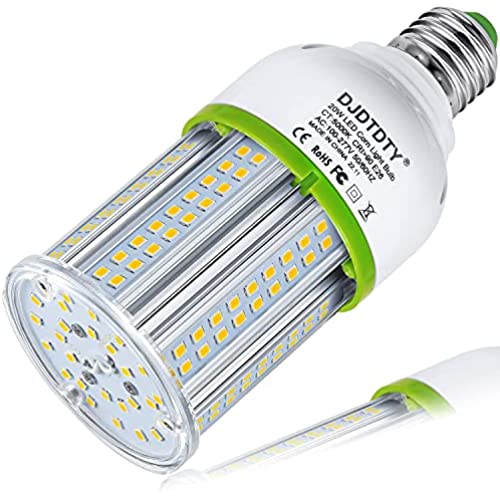
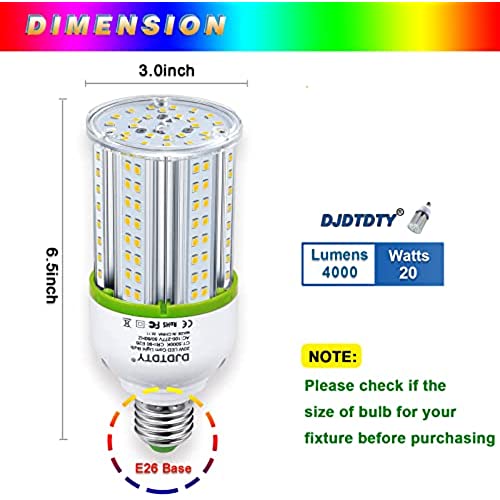
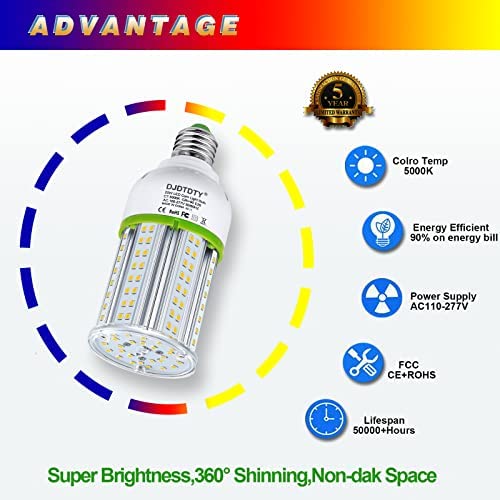
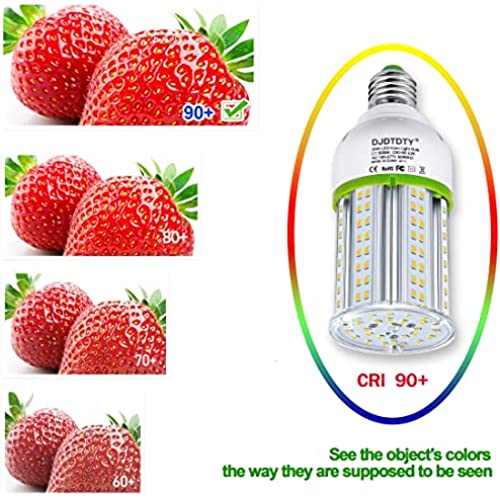
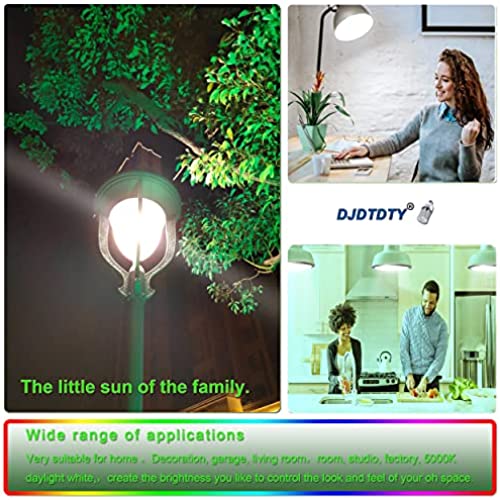
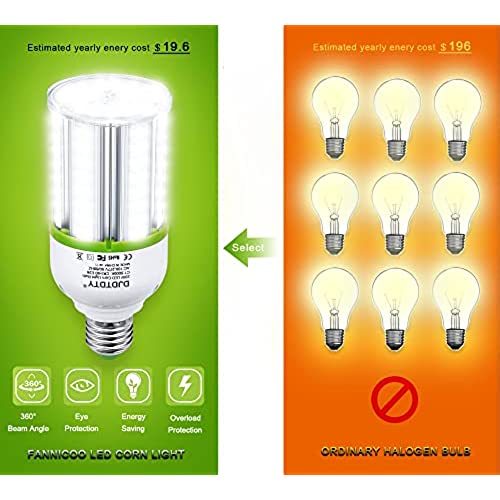








DJDTDTY 1 Pack LED Bulbs,20W/ 80W/100W/120W/150W LED Corn Bulb, E26 Base, 4000LM LED Light Bulb for Garage Household Light bulbsWarehouse Workshop Barn (watts, 20)
-

Tonja Kelly
> 24 hourThese lights are bright! They fit nicely in our front driveway outside sconces and are super bright. They are large but exactly what I was looking for. The addition of the larger adapters is a nice feature and makes these useful in other applications.
-

Addison
> 24 hourGreat workshop or utility room light. Obviously it’s meant to be covered or in a room that you don’t mind the visual aesthetic of it, but it’s very bright and nice to know that you aren’t using a lot of energy to keep this on. Doesn’t seem to get too hot after leaving it on for a while.
-

Agent 19
> 24 hourUpdate: Second light was installed in a wall pack that originally held a 150W HPS bulb. Transformer had to by bypassed. Very bright but its hard to tell if it is brighter than the HPS due to the difference in color. The LED uses less power and if it last five years like the HPS bulbs have, it will be a great value in energy savings alone. Initial review: I installed the first of two in a large open attic - and wow! It is bright but not beyond expectations. The next one will be installed high-pressure sodium wall pack. The transformer will have to be bypassed which hasnt been done yet. If it works as well as the one in the attic, it will dazzle folks arriving in the parking area. So far, its and excellent light for the price.
-

MJA
> 24 hourI honestly thought I was ordering a pair of 150-watt LED lightbulbs. But the only way to get to 150 watts is to add the wattage of both bulbs together. Each of these bulbs is only 72 watts (NOT 150 watts), which I think is very misleading from the product description. Worse, I tested this bulb against a 50-watt basement/garage LED lightbulb – one that has individual panels that swing down (like the “As Seen on TV” brand), which is what I was ordering this bulb to replace. My lightbulb clearly outperforms this bulb. Read on for details of my tests and then see the corresponding photos. I’ll refer to this bulb at “the corn bulb,” and I’ll refer to my bulb that I used in the tests as “the panel bulb.” See Photo 1, which shows the wattage of both bulbs. Specifically, this corn bulb is 71.64 watts (NOT 150 watts), and my panel bulb is 50.43 watts. I tested them in my basement ceiling light fixture by placing a table directly beneath the light. That table was at waist height and approximately 60 inches below the light fixture. I then placed a light meter on that table to record the number of lux (lumens per square meter) that each lightbulb produced at the level of the table (i.e., at the level you would typically be doing a task). I also placed a mirror on the table so you can see the reflection of each lightbulb being tested. See Photo 2 for the results of that test. Specially, my panel bulb produced 974.6 lux, while this corn bulb produced less than one-third of that result – only 313.2 lux. And remember, my panel bulb is only 50 watts, while this corn bulb is 72 watts (i.e., this corn bulb uses 44% more power consumption and produces substantially fewer lux). However, in all fairness, look carefully at the reflection of the ceiling in the mirror. The ceiling is very brightly lit by the corn bulb, while it is much darker in the photo using my panel bulb, because the panels do direct all the light downward. If I installed a reflective shade behind the corn bulb, the lux output would clearly increase. So the design of this corn bulb does direct a lot more light at the ceiling level. This could be helpful in warehouse situations where shelves of product are stacked to the ceiling or helpful in your home closet to illuminate the top shelving above your clothes. But note, you can achieve this same effect with my panel bulb by simply pivoting some of the panels to shine upward. My last test was pointblank comparing the brightness of the bulbs with my eyes. As I mentioned, I had specially ordered these corn bulbs to use in my basement as an alternative to my panel bulbs. Since I thought each corn bulb was 150 watts, I was expecting these bulbs to brighten my basement substantially more than the 50-watt panel bulbs I was using. The opposite is what happened: the corn bulb is noticeably dimmer to the naked eye, which you can see for yourself. I stood right below the light fixture and took a photo of a room divider just a few feet in front of me that was being illuminated by the lightbulbs. And I used the same manual camera settings to take the photo using each lightbulb so that the camera would not make any automatic adjustments for the differing light levels. See Photo 3 for a comparison of how well lit the room divider was using this corn bulb vs. my panel bulb. No question, this 72-watt corn bulb produces less overall room filling light than my 50-watt panel bulb. And let me just add, my 50-watt panel bulb is significantly cheaper than this corn bulb. Bottom line for me: I’m sticking with my LED panel bulbs. They work much better than this corn bulb while using substantially less wattage.
-

Grace Churchill
> 24 hourI have tried a crap ton of different light sin my garage and was frustrated by the fact that no matter what those others claim to do they failed to give me the bright white light I wanted! Then I saw these and decided to give them a try. Now I have the BRIGHT WHITE LIGHT COVERAGE I WANTED!! No more dark corners or crevices or any dark places. (The joke in my garage is that we could probably get a tan from these things.) All kidding aside, the multiple angles and lights on these is wonderful. they provide so much light and clear vision that I wish I had found them years ago. Now I no longer have to get a flashlight to see in the corners.
-

Mac Miller Sr.
> 24 hourSupposed to be 15000 lumens. More like 8000. If you buy divide advertised lumens by 2 for what you need.
-

D J L
> 24 hourIts almost to the point I need to wear sunglasses in the outbuilding. These fit a normal socket but that is where normal end. These are very bright and very efficient, they dont take all the amps of the breaker yet deliver. I am very happy with these.
-

JM
> 24 hourProduct is marked and advertised as 150w worth of LEDs. When metered I read that it only is 82w, which is about half the rated power. While certainly bright for 80w of consumption, its only half what is advertised on the product.
-

Jessica Z.
> 24 hourIt fit perfect, its bright and it its lightweight! Im happy with it so far!!
-

WRH
> 24 hourJust for fun I screwed this into a floor standing torchiere light. So bright I could barely look at it. Couldnt even get a good picture of it. Sure lit the room up though. These will never fit into a standard lamp. They are way to big. The bulbs come standard with E26 threaded connectors (standard light socket) but also come with E36 adapters that could be used to replace a screw in metal Halide light outside. Dont forget to remove the ballast before doing that though, These seem to be very well made, came well packaged and I cant find a thing wrong with them. These are easy to rexommend for anybody that may have a need for a super bright loghtbulb. For all the lumens you are buying, these are a good value.





